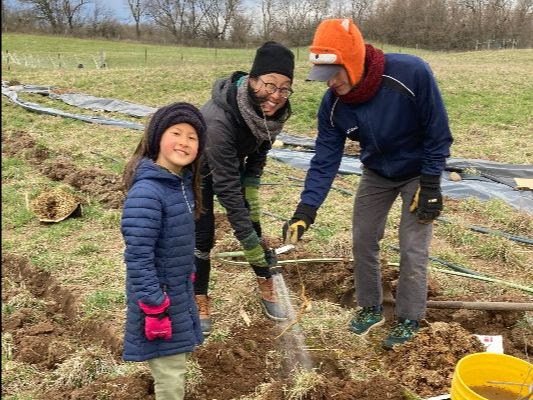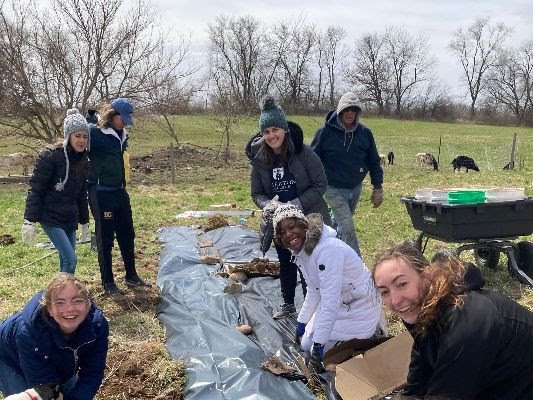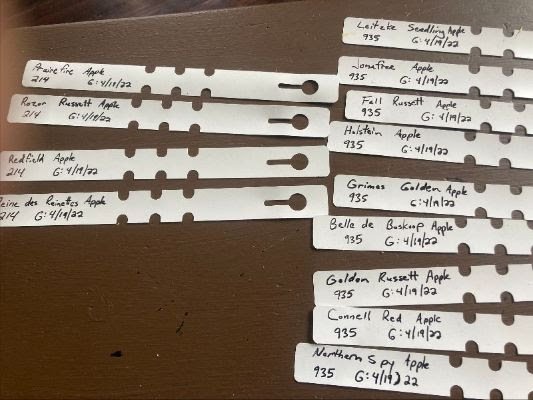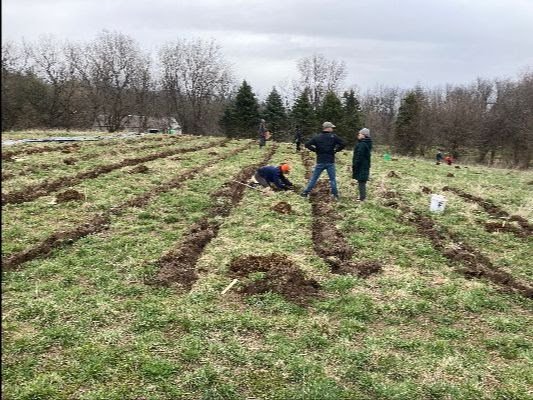FARM UPDATES
It has been a very busy April here at Root & Sky Farm! Tree planting party, new piglets, a grant, outdoor farmers market starts, and much more!
104 trees are in the ground, as the start of our orchard is taking shape! We had about twenty volunteers come out on a cool and breezy day to help our planting day be an amazing success! TONS of digging, compost carting, tree planting, and hot cross buns and soup being consumed! Thank you to everyone that was able to help. The generosity of your time was remarkable! Irrigation is now set, and there are a few more rows to tarp (I'll go over why we are using plastic in future post), but we are getting very close to having everything in place. Most of the fruit is three or four years away, so there will be time for more info on the orchard, but our farm centers around our livestock, so...
April is a transition month from winter to summer. It has been cooler and wetter than most previous March and April months, but there are some tasks that I need to take care of to get ready for livestock moving. I use hundreds of feet of hose to bring animals their water, so testing the hoses for leaks and doing some repairs where needed is on the list. I'm also examining some of our portable electric fence and seeing what needs to be repaired or replaced for the 2022 season. Also, a wind storm took our outdoor chicken houses and smashed them to pieces, so that will be a project for this week. Not very glamorous tasks, but necessary with the influx of livestock that we will be rotationally grazing our pastures and woods. For example, we will have two groups of pigs at the same time on the farm, which is a first for us. It will be more work, but to keep up with demand for forest raised pork, it will be worth the extra time. I hope to be able to offer a few more half/whole hogs this fall, but more on that in the coming months.
As mentioned above, we have eight 35 lb gilts (female pigs that have not had babies yet) that are all from the same litter! It's had to believe that these gals will be nearly 300 lbs by October, but I can't think that far ahead at the moment. It will be a little chilly this week, so they will be trained to electric fencing in our forest that includes a straw filled shed, so these little balls of muscle will be able to stay warm at night. Pig piling is a real think, and that is also how they stay warm. I do need to take a pic of that because it is pretty cute.
I also have about 200 broiler chickens that will be making their way outside next week. We are monitoring the bird flu that have been reported very close by. Migrating domestic birds that may be immune are spreading the disease through droppings and saliva, and if vulnerable birds come in contact with the flu it is most likely a death sentence. Baker's Lake, in Barrington, reported hundreds of water birds dead from the disease. In the US, over 30 million birds have died (or have been put down) because of the avian flu. Chickens, turkeys, and ducks have also been infected in other areas of the country. Being a pastured poultry operation, animals should have fresh air to breath compared to larger indoor operations that have had outbreaks, but the herons and other birds that died at Baker's Lake shows that it can still be very dangerous for outdoor birds. I might do smaller batches of chickens this spring to help minimize possible losses if we did contract the virus, and then when the flu peters out in the heat and dry weather of summer, I hope to get a few larger groups to stock up for fall and winter sales.
Also, I wanted to announce that we received a grant from the Frontera Foundation to put a perimeter fence around most of our property! We greatly appreciate the work Frontera does for local food, and are humbled to be chosen! Right now we only use portable fencing, and if an animal gets out...anyway, it's happened and we have a subdivision to our north and plenty of other homes near by, which adds a great deal of stress. I've had plenty of nightmares of livestock loose, so if an animal does give us the slip, they most likely will still be on our property after the install. This also allows for us to be a little more aggressive where the cattle and sheep can graze, which will help keep weeds, invasives, and grasses under control in some areas that are rarely touched. Grant work can take a lot of time, so it was encouraging to get one of our two applications accepted! Plus, visits to the restaurant, and we have multiple Frontera/Bayless cookbooks and we keep a jar of Green Chile Adobo in our fridge at all times. We started this farm with very little infrastructure and we do shy away from long term debt when possible. It's great that we can re-invest in the farm in other ways besides fencing, thanks to the Frontera Foundation Grant.
There is one final topic that I'm not excited to write about, but it is our pricing. I do strive to give transparency about what we are doing over here, and I am raising prices on a few products. The two main reasons center on the rising feed costs and how inflation is affecting our business. I only purchase organic non-GMO grain for our pigs, chickens, ducks, and turkeys. Their feed costs continue to rise, and that was after going up 30% last year. I have been able to keep most pricing the same as when I started selling four years ago, but my margins are not that great to start with, so there will be some increases. Last year, I was not motivated to increase the beef and lamb because they are 100% grass fed (or hay in the winter), but now increases in hay prices, processing, fencing equipment and supplies, animal purchases costs, and fuel (I put on over 15,000 miles year for the farm in a 17 mpg pickup) is contributing to a slight increase in all areas. Increasing pricing further, scaling up number of livestock on farm, or focusing on less enterprises would probably help my margins, but we do want our products accessible to as many people as possible while offering diversity of livestock for the consumer, but also for the health of the land. Different livestock bring different values to the farm, so it's difficult to think about changing the species right now. Our land is not stressed by the number of livestock we have, but this farmer might be more stressed with an increase in quantity right now. Perimeter fencing will help with stocking density, and maybe maybe some outside labor would make sense for us in the future, but trying to have some family life and work balance is also important as our kids get older.
We have started our fourth year at the Woodstock Farmer's Market in Woodstock, IL. If you have never attended our Saturday market (8 AM - 1 PM), it is one of the largest producers only markets in the state. Every item is raised or created by the people selling at the market, and re-selling is not permitted. We have terrific customers that support us, and it is great to be able to answer questions and take total credit for their excellent meals they create with our products :) Seriously though, it is great to understand what our customers are looking for, and to better understand why they purchase from us versus the many other options available to them. It's been a great experience and I've made many friends through that connection. Come visit if you are in the area!
We've had quite a month! Thank you if you've made it this far in the newsletter. Below the planting pics is our sales info and updates and expectations about our upcoming offerings! Thank you again for reading, and I'll be back next month!
Volunteers working on orchard rows and tree labels prepped of the apple trees that I grafted.





